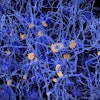Thieme, New York, 2002, $179
Dr. Francis Burgener has patterned Differential Diagnosis in MRI after earlier textbooks such as Differential Diagnosis in Conventional Radiography. This new title adds authors, but retains the overall organization of the first books by listing various differential diagnoses according to anatomic location.
Each chapter concisely lists diagnostic criteria for many disease processes along with various informational comments. The differential diagnoses are presented in an easy-to-read table format, and the text is replete with good-quality MR images. Each chapter contains one or more basic anatomic line drawings that demonstrate the key features used to locate the pathologic entities that follow.
The differential diagnosis format works best in the sections on the brain, head and neck, and spine because of the diagnostic tradition of grouping pathology by location. The chapters on the heart and mediastinum, the liver, biliary system, and the spleen are also well organized and illustrated.
However, the format does have its shortcomings. Certain organ systems lend themselves to location-based lists of differential diagnoses. But the large number of findings and complex technical parameters found in MRI do not translate as well into an image collection of diagnoses as they would on CT or x-ray.
The differential diagnosis format is also not effectively applied in all sections of the book. For example, the differential diagnosis for soft tissue lesions of the musculoskeletal system is too broad and not particularly useful.
The chapter on the pelvis is also is limited by the format. Entities in this section include a wide variety of pathology, which is perhaps overwhelming as a reference. On the other hand, the sections on the shoulder, the elbow, the wrist, the hip and the ankle lack illustrations of some of the most common injuries in these locations (i.e. glenohumeral instability, distal biceps tendon tear, scaphoid fracture, acetabular labral tear, posterior tibial tendon tear).
This book would be most useful for individuals who wish to glean short segments of information on a specific disease process, or for those interested in seeing the panoply of various diseases that can occur in a specific location.
Due to its format, certain sections contain too many entities and cross too many organ systems to function effectively as a reference. The complexity of MR imaging also makes the differential diagnosis focus of this text difficult to successfully illustrates. This book is recommended for those who seek to refine their differential lists across a wide variety of anatomic locations and organ systems.
By Dr. Douglas P. BeallAuntMinnie.com contributing writer
October 8, 2002
Dr. Beall is a staff radiologist in the musculoskeletal division, department of radiology at Wilford Hall Medical Center, Lackland Air Force Base, TX. He also is an assistant professor of radiology, department of radiology and nuclear medicine, Uniformed Services Health University in Bethesda, MD. He is the author of Radiology Sourcebook: A Practical Guide for Reference and Training.
If you are interested in reviewing a book, let us know at [email protected].
The opinions expressed in this review are those of the author, and do not necessarily reflect the views of AuntMinnie.com.
Copyright © 2002 AuntMinnie.com


.fFmgij6Hin.png?auto=compress%2Cformat&fit=crop&h=100&q=70&w=100)





.fFmgij6Hin.png?auto=compress%2Cformat&fit=crop&h=167&q=70&w=250)











